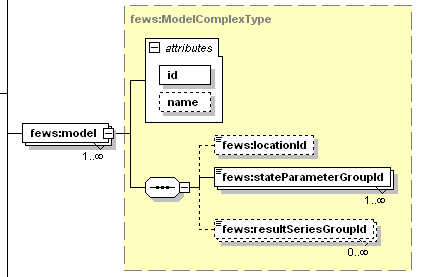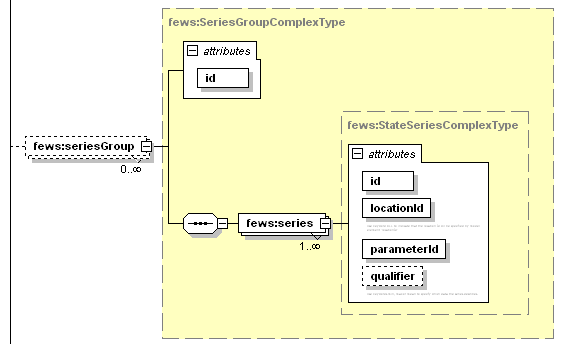Interactive editing of model states
See schema at https://fewsdocs.deltares.nl/schemas/version1.0/stateEditor.xsd
Several operational forecasting systems utilise conceptual hydrological models for calculating the response of a catchment to rainfall. These models typically contain a number of parameters and state variables. A common requirement within the forecast process is the updating of state variables so that the results of the models is closer to the observed behaviour. The updating of states on the basis of observed errors is often referred to as data assimilation.
...
Definition of the a group of models. This will appear as a folder in the treeview. The attributes are;
id Identifier for the group for later reference
name Name of the group to be displayed in the tree view
modelId
list of identifiers of models included in this group (one or more)
modelGroupId
list of identifiers of model groups included in this group (one or more). This allows recursive definition so that a complete tree can be formed. Obviously circular references are not supported.
model
definition of the models for which state variables/parameters are available for editing.
id Identifier for the model for later reference
name Name of the model to be displayed in the tree view (id is used if not defined).
locationId
Location identifier associated to this model. This is used for matching time series to the this model.
stateParameterGroupId
Identifier of the group of parameters considered in this model state. The parameters and their properties are defined in the stateParameterGroup element.
resultSeriesGroupId
Identifier of the result time series. The locationId is used in matching a model to a time series.
stateParameterGroup
Definition of the groups of parameters. For each model type a group needs to be defined. Different calibrated of the same model may allow different sets of parameters to be edited.
id Identifier for the parameter group for later reference
stateParameterId
List of identifiers of the parameters included in the group. The properties of the parameters are defined in the stateParameter section.
seriesGroup
Definition of a time series to be shown in the lower plot of the display. This time series should be associated to the model response to give guidance on the changes made to the state parameters.
id Identifier for the group of time series. This is for reference
name Name of the group of time series.
series
Definition of a time series. This definition is related to the definition of time series in the PI-Web Service. The identifiers used in this series groups there, must be related to identifiers to time series objects in the definition of the PI-Service.
id Identifier for the time series object as defined in the PI-Web Service configuration.
locationId Identifier for the location of the time series. If this is a group of time series then the key word $ANY$ should be used. The locationId associated to a model selection will then be filled run-time
parameterId Identifier of the parameter of the time series. This is the same parameter uses as externalParameter in the configuration of the idMapping.
qualifier
Qualifier for the time series. This may be min, max or mean. Used only for displaying parameter climatology.
stateParameter
Definition of the parameters in a state. These can then be referenced in a stateParameterGroup.
id Identifier for the parameter for later reference
name Name of the parameter to be displayed (id is used if not defined).
range
Range of the parameter
min Minimum parameter value
max Maximum parameter value
inputSeries
Input data series for displaying as the time series of this parameter. This should relate to the time series for the current parameter. There is no explicit check if this is the case. See definition of series
outputSeries
Output data series to write the amended values of the state to. This should relate to the time series for the current parameter, and typically is a non equidistant time series. There is no explicit check if this is the case. See definition of series.
climatology
Definition of the climatology as a time series within this configuration. This is defined as eventData, with a given max, min and mean.
climatologySeries
Definition of the climatology as a time series obtained from the FEWS database (preferred option). A series can to be defined for the min, max and mean at each location. The qualifier can be used to assign a series to each of these.
Configuration of the Explorer to open the State Editor Pi-Client
To run the State Editor display, this needs to be configured as a task. This should be defined as a call to the appropriate class of the external web service client. The arguments are
• Name of the configuration of the PI-Web Service Client and the PI Web Service itself. These names should be the same.
• The IP address of the computer on which the Pi-Service is run. Typically this will be on the local machine and the keyword %HOSTNAME% can be defined.
• The port on the computer on which the Pi-Service is run. Again this is typically defined by FEWS itself when running on the local machine and need only be specified when running remotely. When used locally the key word %PORT% should be used.
| Code Block | ||||
|---|---|---|---|---|
| ||||
<explorerTask name="SAC SMA State Editor">
<iconFile>""</iconFile>
<mnemonic>C</mnemonic>
<arguments>SACSMA_StateModifiers %HOSTNAME% %PORT%</arguments>
<taskClass>nl.wldelft.piclients.statemodifiers.StateEditor</taskClass>
<toolbarTask>false</toolbarTask>
<menubarTask>true</menubarTask>
</explorerTask>
|


